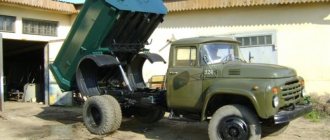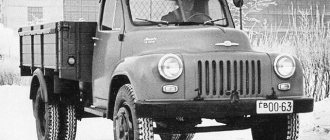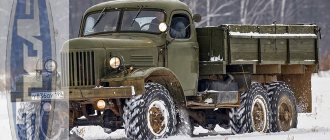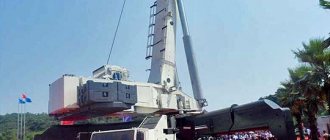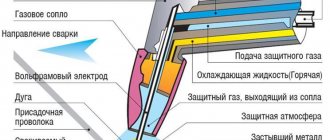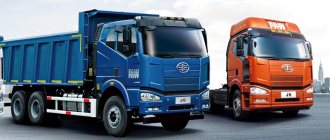Author: Vossen
March 17, 2016 11:40
Tags: GAZ 56 GAZ-51 gases history
3875
23
By the mid-thirties, the GAZ lorry, a licensed Ford AA, was outdated and there was a need for its replacement. Here it is - the bestial grin of capitalism: old Henry Ford, despite his ardent anti-communism, anti-Semitism and sympathy for the German National Socialists, all this did not stop him from cutting coupons from these same communists. However, the contract with Ford ended and Soviet designers developed the replacement for GAZ-AA themselves. Of course, they looked back at the Americans, but who didn’t look back at them back then!? Design of a new car with a six-cylinder in-line carburetor engine GAZ 11 with a power of 76 hp. s., which received the GAZ-51 brand, began in February 1937 under the leadership of designer V.M. Kudryavtseva. In June 1938, production of components began, in January 1939, assembly began, and already in May the first car entered road tests, which ended in July 1941. A number of sources call it GAZ-11-51, but in factory documents from the very beginning the car had the index “51” - the engine index did not appear in the names of GAZ truck models, unlike passenger cars of that time with the GAZ-11 engine, which were included in history with “11” in its index. In the summer of 1940, a prototype GAZ-51 was exhibited at the All-Union Agricultural Exhibition in Moscow. The second prototype, built in September 1940, after a run of 32,500 km, was equipped with a gas generator unit and worked at the plant for several more years. The tests were successful, and preparations began for serial production of the GAZ 51, which was to begin in 1942, at the beginning of the IV Five-Year Plan. But the outbreak of the Great Patriotic War disrupted these plans.
GAZ 11-51 Experienced '1939
0
Source:
Work on promising cars resumed in 1943. The rapid development of technology during the war years made inevitable adjustments to the design of the GAZ-51. Leading designer A.D. Prosvirnik (chief designer of the plant since 1968) radically reconfigured and modified the car, and essentially only the name remained from the pre-war GAZ-51. The accumulated experience in operating six-cylinder engines on combat vehicles has made it possible to significantly improve the engine and the systems that serve it. The carrying capacity was increased to 2.5 tons. However, the topic of the heir to the “lorry” was not abandoned.
0
Source:
0
Source:
High class cars
The first high-class passenger car was the GAZ-12 ZIM. This happened in 1948, when the management received a corresponding assignment from the government. Industrial production of high-quality cars began in 1950. The public gasped with delight, because the car was equipped to the highest class:
- heating system in the rear seats;
- three-band radio system;
- automatically resetting turn signals;
- the most powerful engine at that time (95 horses);
- high speed limits.
Following it, an SUV was released, which was actively sold not only in the USSR, but also in other countries. It was GAZ-69, production of which began in 1953. Three years later, an important event occurred not only in the history of the plant, but also of the entire domestic industry - the production of the first Volga, or GAZ-21. This event marked the beginning of a new century in the development of the industry. The Volga underwent repeated modernizations, which resulted in the GAZ-22 and the export model.
All ideas about a Russian classic car were embodied in the GAZ-21. There were a lot of advantages and disadvantages:
- the 70-horsepower engine had a wedge-shaped combustion chamber;
- the car could be accelerated to 130 km/h;
- more advanced dynamics even in comparison with “Victory”.
A very clear picture: “ancestor” and heir” - GAZ-AA and GAZ-51
0
Source:
After the Victory, it was decided to return to the topic of a small delivery truck, which the Soviet national economy was in dire need of. The Ulyanovsk Automobile Plant was the first to create a new “lorry”, which began developing its first own model, called the UAZ-300, back in 1947. Ulyanovsk residents presented the first copy of the promising “lorry” at a festive demonstration on November 7, 1949. The first version of the car's appearance was very similar to the GAZ-51, but in 1948 the factory workers developed an original and very successful design. What’s interesting is that there was no full-time artist-designer at the plant at that time! GAZ employees offered their own version of the appearance, but theirs turned out to be more attractive.
The era of big cars
After the production of passenger cars, the concern's designers set their sights on creating vehicles for other purposes. First, the GAZ-03-30 service bus was released, which instantly gained popularity. After this event, the plant received a master plan, towards the implementation of which all efforts were directed. As a result of fruitful work, a number of cars were created:
- truck with three axles GAZ-AAA;
- dump truck GAZ-410;
- ambulance bus GAZ-55;
- truck with gas generator GAZ-42.
At the same time, the first pickup truck in the history of the plant, based on the GAZ-4 base, saw the light of day.
UAZ 302 Experienced '11.1950
0
Source:
0
Source:
One of the reasons was that in 1951 the Ulyanovsk Automobile Plant was transferred to another branch of industry, under the jurisdiction of the USSR Ministry of Radio Industry, becoming for a time a radio plant. Developments on the UAZ-300/302 were transferred to the Gorky Automobile Plant.
0
Source:
In 1952, the design of a new “one and a half” GAZ-56 began. Development began under the leadership of Alexander Dmitrievich Prosvirnin. Since August 1954, Alexander Butusov, a recent graduate of the Gorky Polytechnic, became the leading designer of the machine. This was the first serious (after designing caravans) task for the young designer.
How it all began
The history of GAZ is not just the stages of development of another automaker. This is an integral part of Russian history, which makes every Russian proud. The well-known “Chaika”, “Volga” and trucks were produced precisely at this enterprise, to which our conversation will be devoted.
The city in which the automobile plant was founded was called Gorky. This is where the history of the name of the greatest automobile production - the Gorky Automobile Plant - came from. Now this city is known as Nizhny Novgorod. Production began in 1932, with the participation of American engineers from the Ford Motor Company. At the beginning of March 1929, the Soviet government approved the decision to build an automobile plant, in April of the same year a site was chosen for future construction, and at the end of May an agreement was concluded with the Americans. A year later, large-scale construction began, which dragged on for 18 months.
GAZ 56 Experienced (I series) '1953–54
0
Source:
The design of the car contained a number of technical solutions unusual for its time: sealed drum brakes, a cam-type self-locking differential, a continuous rear axle housing and a hypoid final drive, telescopic shock absorbers, an overhead shaft engine with pre-chamber-torch ignition of the combustible mixture and an electric coupling for the cooling system fan, springs without grease nipple on rubber bushings. The layout of the car was traditional - hood.
Rare three-axle trucks from Moscow and Minsk plants
Moscow KamAZ (1970-1978)
In 1969, by decision of the government, ZIL began designing cabover diesel trucks for production at the Kama Automobile Plant under construction, based on the experimental ZIL-170 (6x4) civilian vehicles presented a year earlier.
A prototype of the future KamAZ-4310 all-wheel drive military truck built at ZIL. 1971
Two five-ton 6x6 army prototypes with a ZIL-170 cab, built in 1970, successfully passed state tests. In 1978, they covered a range of 18 thousand kilometers and were put into service. In 1981, under the KamAZ-4310 brand, their assembly began in Naberezhnye Chelny.
Promising and useless all-terrain vehicles ZIL-4334 (1978-1992)
The development of the promising diesel family ZIL-4334 (6x6) began in 1978, when an experimental 170-horsepower version of the ZIL-131M was created on the serial ZIL-131. At the same time, a four-ton prototype E4334
with a 185 hp V8 diesel engine, synchronized gearbox, wide-profile tires and flat front windows with triangular vents.
Trial army truck ZIL-E4344 with an alligator hood being tested at the 21st Scientific Research Institute. 1978
In 1979-1980, comparative tests of the second sample 2E4334
with a winch, the first version of the E4334 and the ZIL-131M, but all of them could not meet the strict military requirements for reliability, efficiency and degree of crew protection.
Modified version 2E4334 with a winch after completion of state tests. 1979 (archive of 21st Scientific Research Center)
Only nine years later the third version 3E4334
on the ZIL-131N chassis with a multi-fuel engine with a power of 170 horsepower, a new cabin with a rectangular hood and a front facing with lighting devices. A frameless van body K-4334 with flat roof slopes and side light windows was built for it.
Modified version 2E4334 with a winch after completion of state tests. 1979 (archive of 21st Scientific Research Center)
Their development in 1989-1990 was the fourth 3.5-ton prototype 433410
with a reinforced frame and the same engine, used for towing trailers and air transportation by heavy aircraft. Externally, it stood out with a shortened frame and a rounded sloping hood with headlights on the upper edge of the bumper.
Modified version 2E4334 with a winch after completion of state tests. 1979 (archive of 21st Scientific Research Center)
At the same time, an air transportable truck tractor was built using units of the 3E4334 model 443114
for towing 7.5-ton semi-trailers, which until 1992 was tested at Test Site 21 of the Research Institute as a “chassis with a dummy load.” It was distinguished by an angular fiberglass cabin with flat windshields and a blank rear wall, which theoretically had increased resistance to the damaging factors of a nuclear explosion.
Modified version 2E4334 with a winch after completion of state tests. 1979 (archive of 21st Scientific Research Center)
MAZ-6317/MAZ-6425 (1986-1991)
In the mid-80s, the Minsk Automobile Plant presented a sample of an 11-ton army truck MAZ-6317
with an experienced V8 engine of 330 horsepower, a nine-speed transmission and an extended cab. At the end of the tests, it was planned to assemble 12 vehicles for the armed forces of Belarus, equipped with power units of different power (360-420 hp).
Modified version 2E4334 with a winch after completion of state tests. 1979 (archive of 21st Scientific Research Center)
, the MAZ-6425 truck tractor was ready
with the MAZ-938B army low-bed semi-trailer, which worked as part of military road trains weighing up to 44 tons. In Soviet times, it was not possible to bring these promising cars to serial production.
Experienced MAZ-6425 truck tractor with MAZ-938B tank semi-trailer. (archive 21 NIITs)
"GAZelle Next"
The second generation of GAZ commercial light-duty vehicles has been produced since 2013. The GAZelle Next model range includes the following modifications:
- Flatbed version with two cabin options: three-seater or seven-seater, on a standard or extended base.
- An all-metal standard van with a three-seater cabin or a cargo-passenger version with the ability to transport up to seven people.
- Minibuses for various purposes: tourist, school, city.
- Citiline commuter bus with a capacity of up to 19 passengers.
- About 150 different variants of special machines.
Cars of the Gazelle Next series are equipped with more powerful engines, including diesel ones, which increases the power supply of the vehicle. This allows the production of modifications with productive special equipment. Therefore, one of the most popular models are GAZelles with thermal booths, which are equipped with special refrigeration equipment for transporting perishable goods.
Light-duty GAZelle cars: model range on News4Auto.ru.
Our life consists of everyday little things that in one way or another affect our well-being, mood and productivity. I didn’t get enough sleep - my head hurts; I drank coffee to improve the situation and cheer myself up - I became irritable. I really want to foresee everything, but I just can’t. Moreover, everyone around, as usual, gives advice: gluten in bread - don’t go near it, it will kill you; A chocolate bar in your pocket is a direct path to tooth loss. We collect the most popular questions about health, nutrition, diseases and give answers to them that will allow you to better understand what is good for your health.



